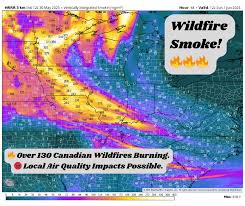Current Smoke Forecast and Its Implications for Canadians

Understanding the Importance of Smoke Forecasts
As we move deeper into the summer of 2023, Canadians are increasingly facing the impacts of wildfires across the nation. The smoke forecast has become an essential tool not only for public safety but also for managing public health responses to poor air quality. With a mix of changing weather patterns and human activity contributing to the frequency and intensity of these wildfires, understanding smoke forecasts is vital for planning daily activities and ensuring safety.
Current Smoke Conditions Across Canada
According to Environment Canada, several provinces, including British Columbia, Alberta, and Ontario, are experiencing significant wildfire activity. Reports indicate that thousands of hectares have been burned, leading to extensive smoke production. The air quality in affected regions is deteriorating, often reaching hazardous levels. For instance, in British Columbia, the Air Quality Health Index (AQHI) has shown ratings indicating serious health risks for sensitive populations.
Impact of Smoke Forecast on Health and Daily Life
The smoke forecast is particularly crucial for vulnerable groups, including children, the elderly, and those with existing respiratory conditions. As smoke can carry harmful particulates deep into the lungs, it can aggravate conditions like asthma and lead to increased hospital visits. Public health officials encourage individuals to monitor smoke forecasts and take precautions such as remaining indoors during high smoke periods and using air purifiers.
The smoke forecast not only informs residents about when to limit outdoor activities but also aids local governments in decision-making regarding the closure of public spaces, schools, and outdoor events. The accessibility of real-time smoke forecast data has enhanced community preparedness and response capability.
Resources for Monitoring Smoke Conditions
Canadians are encouraged to utilize resources like the Government of Canada’s Air Quality Health Index website and provincial wildfire management pages, which provide updates on smoke conditions, health advisories, and safety tips. Additionally, many local news outlets and weather apps now include real-time smoke forecasts to assist residents in planning their daily activities.
Conclusion: The Future of Smoke Forecasting
As the climate continues to change, experts predict that the frequency and intensity of wildfires may increase, leading to more prolonged periods of poor air quality due to smoke. This underscores the importance of smoke forecasting as a vital societal tool in protecting health and ensuring safety. By staying informed and utilizing available resources, Canadians can better navigate the health risks associated with smoke and foster community resilience when faced with wildfire threats.









